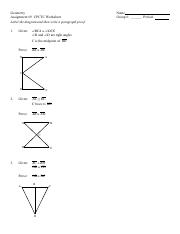

SSS (Side-Side-Side Correspondence): If three pairs of corresponding sides have the same length of measure, the two triangles are congruent.SAS (Side-Angle-Side Correspondence): If two pairs of corresponding sides have the same length and the pair of corresponding angles has the same measure, the two triangles are congruent.The premises of an inductive logical argument indicate some degree of support for the conclusion they suggest truth, but do not ensure it. Inductive Reasoning: Drawing conclusions from several known cases reasoning from the particular to the general.Included Side: A side of a triangle whose endpoints are the vertices of two consecutive angles of the triangle.Included Angle: An angle of a triangle whose vertex is the common endpoint of two consecutive sides of a triangle.Hypotenuse-leg: In right triangles, if the hypotenuse and one leg of one triangle are congruent to the hypotenuse and another leg of a second triangle, then the two triangles are congruent.Deductive Reasoning: A method which arrives at conclusions from accepted principles reasoning such that the conclusion necessarily follows from a set of premises.Corresponding Sides: Sides in the same relative position in similar or congruent figures.Corresponding Angles: Angles in the same relative position in similar or congruent figures.Congruent: Having the same size and shape.ASA (Angle-Side-Angle correspondence): If two pairs of corresponding angles have the same measure and the pair of corresponding sides has the same length, the two triangles are congruent.AAS (Angle-Angle-Side correspondence): If two pairs of corresponding angles have the same measure and the pair of third sides (not included) has the same length, the two triangles are congruent.There are some mathematical relationships that are always true and these relationships are used as the rules of arithmetic and algebra and are useful for writing equivalent forms of expressions and solving equations and inequalities.Spatial reasoning and visualization are ways to orient thinking about the physical world.Some geometric relationships can be described and explored as functional relationships.

Congruence describes a special similarity relationship between objects and is a form of equivalence.

Numbers, measures, expressions, equations, and inequalities can represent mathematical situations and structures in many equivalent forms.Mathematical statements can be justified through deductive and inductive reasoning and proof.The following illustrations show two parallel lines cut by a transversal (You may assume that even though the lines are not marked parallel, the two lines that look parallel, actually are).

What if you were given two triangles with all the angle measures and all the side lengths marked? How could you tell if the two triangles were congruent? When referring to corresponding congruent parts of congruent triangles, you can use the phrase Corresponding Parts of Congruent Triangles are Congruent, or its abbreviation CPCTC. Notice that when two triangles are congruent their three pairs of corresponding angles and their three pairs of corresponding sides are congruent.


 0 kommentar(er)
0 kommentar(er)
